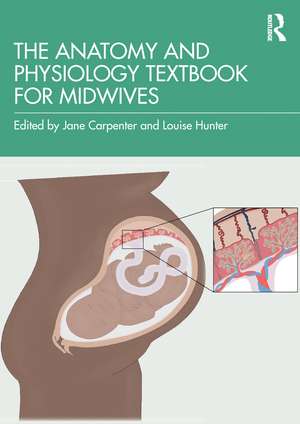The Anatomy and Physiology Textbook for Midwives
Editat de Jane Carpenter, Louise Hunteren Limba Engleză Paperback – 20 ian 2025
This textbook follows the journey from pre-conception to the puerperium. Divided into six parts, it begins with foundational material before moving onto reproduction, embryology and fetal development. The central sections of the book consider maternal changes and adaptations during pregnancy, the intrapartum period, and the puerperium and transition from fetal to neonatal life. The book finishes with a section looking at lactation. Containing numerous full colour illustrations, each chapter includes application to practice boxes, “challenge” sections, and “interrupters” to help you consolidate their learning. The text is accompanied by a downloadable interactive workbook to complete as you read.
Written in a clear and accessible style, The Midwifery Anatomy and Physiology Textbook is an essential read for pre-registration midwifery students, studying at both BSc and MSc levels.
Preț: 241.76 lei
Preț vechi: 314.99 lei
-23% Nou
Puncte Express: 363
Preț estimativ în valută:
46.26€ • 48.43$ • 38.28£
46.26€ • 48.43$ • 38.28£
Carte nepublicată încă
Doresc să fiu notificat când acest titlu va fi disponibil:
Se trimite...
Preluare comenzi: 021 569.72.76
Specificații
ISBN-13: 9781032130842
ISBN-10: 1032130849
Pagini: 480
Ilustrații: 516
Dimensiuni: 174 x 246 mm
Ediția:1
Editura: Taylor & Francis
Colecția Routledge
Locul publicării:Oxford, United Kingdom
ISBN-10: 1032130849
Pagini: 480
Ilustrații: 516
Dimensiuni: 174 x 246 mm
Ediția:1
Editura: Taylor & Francis
Colecția Routledge
Locul publicării:Oxford, United Kingdom
Public țintă
Undergraduate Advanced and Undergraduate CoreCuprins
Foreword
Section 1: The Foundations for Life
1.1: The Human Cell
1.2: Tissues
1.3: Homeostasis
Section 2: Reproduction and Fetal Development
2.1: Mitosis and Meiosis
2.2: Genetics, Genetic Disorders and Epigenetics
2.3: Male and Female Reproductive Systems
2.4: Reproduction and Embryology
2.5: The Placenta and Developing Fetus
Section 3: Maternal Changes and Adaptations to Pregnancy
Chapter 3.1: The Blood and Cardiovascular System
Chapter 3.2: The Respiratory System
Chapter 3.3: The Nervous System
Chapter 3.4: The Endocrine System
Chapter 3.5: The Musculoskeletal System
Chapter 3.6: The Renal System
Chapter 3.7: The Gastrointestinal System
Chapter 3.8: The Immune System
Section 4: Labour and Birth
Chapter 4.1: The Maternal Pelvis
Chapter 4.2: Physiology of First Stage of Labour
Chapter 4.3: The Physiology of the Second Stage of Labour
Chapter 4.4: The Fetus during Labour
Chapter 4.5: The Third Stage of Labour
Chapter 4.6: Pelvic Floor and Perineum
Chapter 4.7: Changes to Body Systems in Labour and Birth
Section 5: The Puerperium
Chapter 5.1: Maternal Postnatal Physiology
Chapter 5.2: The Transition from Fetal to Neonatal Life
Section 6: Lactation
Chapter 6.1: The Constituents of Breastmilk
Chapter 6.2: The Anatomy of the Breast and the Physiology of Lactation
Chapter 6.3: Supporting and Maintaining Breastfeeding
Section 1: The Foundations for Life
1.1: The Human Cell
1.2: Tissues
1.3: Homeostasis
Section 2: Reproduction and Fetal Development
2.1: Mitosis and Meiosis
2.2: Genetics, Genetic Disorders and Epigenetics
2.3: Male and Female Reproductive Systems
2.4: Reproduction and Embryology
2.5: The Placenta and Developing Fetus
Section 3: Maternal Changes and Adaptations to Pregnancy
Chapter 3.1: The Blood and Cardiovascular System
Chapter 3.2: The Respiratory System
Chapter 3.3: The Nervous System
Chapter 3.4: The Endocrine System
Chapter 3.5: The Musculoskeletal System
Chapter 3.6: The Renal System
Chapter 3.7: The Gastrointestinal System
Chapter 3.8: The Immune System
Section 4: Labour and Birth
Chapter 4.1: The Maternal Pelvis
Chapter 4.2: Physiology of First Stage of Labour
Chapter 4.3: The Physiology of the Second Stage of Labour
Chapter 4.4: The Fetus during Labour
Chapter 4.5: The Third Stage of Labour
Chapter 4.6: Pelvic Floor and Perineum
Chapter 4.7: Changes to Body Systems in Labour and Birth
Section 5: The Puerperium
Chapter 5.1: Maternal Postnatal Physiology
Chapter 5.2: The Transition from Fetal to Neonatal Life
Section 6: Lactation
Chapter 6.1: The Constituents of Breastmilk
Chapter 6.2: The Anatomy of the Breast and the Physiology of Lactation
Chapter 6.3: Supporting and Maintaining Breastfeeding
Notă biografică
Jane Carpenter, Before becoming a midwife, Jane studied Biology at BSc, MRes and DPhil level. She then completed her Midwifery education. Jane is now Lead Midwife for Education at Oxford Brookes University, with a passion for midwifery education and midwifery research. She also maintains her lifelong love of biology, and more specifically, for all things anatomy and physiology in childbearing related.
Louise Hunter, Louise is a Midwife and Midwifery Educator with a keen interest in inclusivity and lactation. A former Lead Midwife for Education, she is now an examiner for the NMC Test of Competence and a Breastfeeding Supporter for the Breastfeeding Network.
Louise Hunter, Louise is a Midwife and Midwifery Educator with a keen interest in inclusivity and lactation. A former Lead Midwife for Education, she is now an examiner for the NMC Test of Competence and a Breastfeeding Supporter for the Breastfeeding Network.
Descriere
Focusing on optimising the normal biological processes of reproduction and early life, and in line with the NMC Future Midwives Standards, this comprehensive textbook introduces the fundamental anatomy and physiology knowledge needed for midwifery practice.
